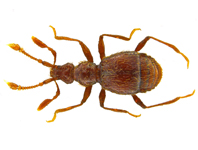Abstract
Bromeliads (Bromeliaceae) are an extremely diverse family of the angiosperms widely distributed in the tropical and subtropical regions of the Americas and West Africa. They often serve as phytotelmata, accumulating rainwater between leaves. Such water reservoirs can be inhabited by diverse organisms. But to date not much attention is paid to inventory of these organisms, with careful identification of each taxon. We found a microcrustacean Disparalona hamata (Birge, 1879) (Crustacea: Cladocera) in the bromeliad Tillandsia aguascalentensis Gardner, 1984 in Mexico. Investigated population included parthenogenetic females, gamogenetic females and males. Hereby the population apparently can pass the full life cycle under conditions of phytotelmata. Along with ecological observations, we provide additional taxonomic notes on the genus Disparalona Fryer, 1968 itself. Recently a series of morphological revisions was conducted for this genus. It was subdivided into two subgenera: Disparalona s.str. and Mixopleuroxus Hudec, 2010. But, in fact, the second taxon is a junior synonym of Leptorhynchus Daday, 1905. In this regard here we provide an updated list of taxonomic synonyms for the subgenus Leptorhynchus.
References
Balke, M., Gómez-Zurita, J., Ribera, I., Viloria, A., Zillikens, A., Steiner, J., García, M., Hendrich, L. & Vogler, A.P. (2008) Ancient associations of aquatic beetles and tank bromeliads in the Neotropical forest canopy. Proceedings of the National Academy of Sciences, 105 (17), 6356–6361.
https://doi.org/10.1073/pnas.0710368105
Daday, E. von. (1905) Untersuchungen über die Süsswasser-Mikrofauna Paraguays. Zoologica, Stuttgart, 18, 1–374.
Elías-Gutiérrez, M., Kotov, A.A. & Garfias-Espejo, T. (2006) Cladocera (Crustacea: Ctenopoda, Anomopoda) from southern Mexico, Belize and northern Guatemala, with some biogeographical notes. Zootaxa, 1119, 1–27.
Elías-Gutiérrrez, M., Suárez Morales, E., Gutiérrez Aguirre, M., Silva Briano, M., Granados Ramírez, J.G. & Garfias Espejo, T. (2008) Cladocera y Copepoda de las aguas continentales de México. Guía ilustrada. UNAM, CONABIO, ECOSUR, SEMARNAT-CONACYT, México, D.F., 322 p.
Frank, J.H. (1996) Bibliography of bromeliad phytotelmata. Bromeliad Biota. Available from: http://BromeliadBiota.ifas.ufl.edu/fitbib1.htm (accessed 25 November 2018)
Frank, J.H. & Lounibos, L.P. (2009) Insects and allies associated with bromeliads: a review. Terrestrial arthropod reviews, 1 (2), 125–153.
https://doi.org/10.1163/187498308X414742
Frank, J.H., Sreenivasan, S., Benshoff, P.J., Deyrup, M.A., Edwards, G.B., Halbert, S.E., Hamon, A.B., Lowman, M.D., Mockford, E.L., Scheffrahn, R.H., Steck, G.J., Thomas, M.C., Walker, T.J. & Welbourn, W.C. (2004) Invertebrate animals extracted from native Tillandsia (Bromeliales: Bromeliacea) in Sarasota country. Florida Entomologists, 87 (2), 176–185.
https://doi.org/10.1653/0015-4040(2004)087[0176:IAEFNT]2.0.CO;2
Fuentes-Reinés, J.M., Elmoor-Loureiro, L. & Granados-Martínez, C.E. (2018) New records of Cladocera (Crustacea: Branchiopoda) from the Tomo River, Vichada, Colombia. Nauplius, 26, e2018006.
https://doi.org/10.1590/2358-2936e2018006
Givnish, T.J., Millam, K.C., Evans, T.M., Hall, J.C., Chris Pires, J., Berry, P.E. & Sytsma, K.J. (2004) Ancient vicariance or recent long-distance dispersal? Inferences about phylogeny and South American–African disjunctions in Rapateaceae and Bromeliaceae based on ndh F sequence data. International Journal of Plant Sciences, 165 (Supplement 4), 35–54. [S35–S54]
https://doi.org/10.1086/421067
Guimaraes-Souza, B.A., Mendes, G.B., Bento, L., Marotta, H., Santoro, A.L., Esteves, F.A., Farjalla, P.L. & Enrich-Prast, A. (2006) Limnological parameters in the water accumulated in tropical bromeliads. Acta Limnologica Brasiliensia, 18 (1), 47–53.
International Commission on Zoological Nomenclature (ICZN) (2000) International code of zoological nomenclature. 4th Edition. The Natural History Museum, London, 306 pp.
Jocque, M., Fiers, F., Romero, M. & Martens, K. (2013) Crustacea in phytotelmata: a global overview. Journal of Crustacean Biology, 33 (4), 451–460.
https://doi.org/10.1163/1937240X-00002161
Kolicka, M., Gwiazdowicz, D.J., Hupało, K., Jabłonska, A., Kotwicki, L., Kornobis, F., Lamentowics, A., Magowski, W., Marcisz, K., Pronin, M., Reczuga, A.K., Olszanowski, Z. & Zawierucha, K. (2016) Hidden invertebrate diversity-phytotelmata in Bromeliaceae from palm houses and florist wholesalers (Poland). Biologia, 71 (2), 194–203.
https://doi.org/10.1515/biolog-2016-0026
Kotov, A.A. (2013) Morphology and phylogeny of Anomopoda (Crustacea: Cladocera). KMK, Moscow, 638 pp. [in Russian with English abstract]
Little, T. & Hebert, P. (1996) Endemism and ecological islands: the ostracods from Jamaican bromeliads. Freshwater Biology, 36 (2), 327–338.
https://doi.org/10.1046/j.1365-2427.1996.00094.x
Lopez, L.C.S., Filizola, B., Deiss, I. & Rios, R.I. (2005) Phoretic behaviour of bromeliad annelids (Dero) and ostracods (Elpidium) using frogs and lizards as dispersal vectors. Hydrobiologia, 549 (1), 15–22.
https://doi.org/10.1007/s10750-005-1701-4
Lopez, L.C.S., Alves, R.R.D.N. & Rios, R.I. (2009) Micro-environmental factors and the endemism of bromeliad aquatic fauna. Hydrobiologia, 625 (1), 151–156.
https://doi.org/10.1007/s10750-009-9704-1
Neretina, A.N., Garibian, P.G., Sinev, A.Y. & Kotov, A.A. (2018) Diversity of the subgenus Disparalona (Mixopleuroxus) Hudec, 2010 (Crustacea: Cladocera) in the New and Old World. Journal of Natural History, 52 (3–4), 155–205.
https://doi.org/10.1080/00222933.2017.1411987
Rey, J. & Vásquez, E. (1986) Cladocères de quelques corps d’eaux du bassin moyen de l’Orénoque (Vénézuéla). Annales de Limnologie, 22, 137–168.
https://doi.org/10.1051/limn/1986013
Richardson, B.A. (1999) The Bromeliad microcosm and the assessment of faunal diversity in a Neotropical forest. Biotropica, 31 (2), 321–336.
https://doi.org/10.1111/j.1744-7429.1999.tb00144.x
Romero, J.M., Silva-Briano, M., Adabache-Ortiz, A., Mondragón, D. & Van Damme, K. (2011) Cladocera in Mexican bromeliads. 9th International Cladocera Symposium, Verbania, Italy, 2–8 October, 33.
Sinev, A.Y. (2002) Place of a Central American bromeliad-inhabiting cladoceran Alona bromelicola Smirnov, 1988 within the genus (Branchiopoda: Anomopoda: Chydoridae). Arthropoda Selecta, 11 (2), 109–116.
Sinev, A.Y. (2015) Revision of the pulchella-group of Alona s. lato leads to its translocation to Ovalona Van Damme et Dumont, 2008 (Branchiopoda: Anomopoda: Chydoridae). Zootaxa, 4044 (4), 451–492.
https://doi.org/10.11646/zootaxa.4044.4.1
Smirnov, N.N. (1988) Cladocera (Crustacea) from Nicaragua. Hydrobiologia, 160 (1), 63–77.
https://doi.org/10.1007/BF00014279
Smirnov, N.N. (1996) Cladocera: the Chydorinae and Sayciinae (Chydoridae) of the world. Guides to the identification of the microinvertebrates of the Continental Waters of the world. Vol. 11. SPB Academic Publishing, Amsterdam, 197 pp.
Sousa, F.D.R., Elmoor-Loureiro, L.M.A., Mugnai, R., Panarelli, E.A. & Paggi, J.C. (2018) A revision of the genus Disparalona (Cladocera, Chydorinae) in South America. European Journal of Taxonomy, 460, 1–34.
https://doi.org/10.5852/ejt.2018.460
Varga, L. (1928) Ein interessanter Biotop der Biocönose von Wasserorganismen. Biologisches Zentralblatt, 48, 143–162.
Wittman, P.K. (2000) The animal community associated with canopy bromeliads of the lowland Peruvian Amazon rain forest. Selbyana, 21 (1.2), 48–51.
Zoppi de Roa, E. & Vásquez, W. (1991) Additional cladoceran records for Mantecal and new for Venezuela. Hydrobiologia, 225, 45–62.
https://doi.org/10.1007/978-94-017-0918-7_5

